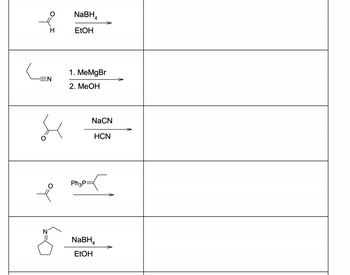
Chemistry
10th Edition
ISBN: 9781305957404
Author: Steven S. Zumdahl, Susan A. Zumdahl, Donald J. DeCoste
Publisher: Cengage Learning
expand_more
expand_more
format_list_bulleted
Concept explainers
Question
Draw structures for the products formed in the following reactions. If more than one product is possible, show all of them, and indicate the major product, if any.

Transcribed Image Text:H
EN
S
to
N
NaBH
EtOH
1. MeMgBr
2. MeOH
Ph3P:
NaCN
HCN
NaBH4
EtOH
Expert Solution
This question has been solved!
Explore an expertly crafted, step-by-step solution for a thorough understanding of key concepts.
This is a popular solution
Trending nowThis is a popular solution!
Step by stepSolved in 2 steps with 1 images

Knowledge Booster
Learn more about
Need a deep-dive on the concept behind this application? Look no further. Learn more about this topic, chemistry and related others by exploring similar questions and additional content below.Similar questions
- Which is the major isolated organic product of this reaction? A) + D) Pd(PPH3)4 NaCO3arrow_forwardPredict the major product of this organic reaction: H+ + H₂O ? Specifically, in the drawing area below draw the skeletal ("line") structure of the major product. If there is no reaction, check the No reaction box under the drawing area.arrow_forwardThese are synthesis questions. You need to show how the starting material can be converted into the product(s) shown. You may use any reactions we have learned. Show all the reagents you need. Show each molecule synthesized along the way and be sure to pay attention to the regiochemistry and stereochemistry preferences for each reaction. If a racemic molecule is made along the way, you need to draw both enantiomers and label the mixture as "racemic".arrow_forward
- Curved arrows are used to illustrate the flow of electrons. Follow the arrows and draw the starting material and product in this reaction. Include all lone pairs and charges as appropriate. Ignore stereochemistry. Ignore inorganic byproducts.arrow_forwardPredict the major products of this organic reaction. Be sure to use wedge and dash bonds when necessary, for example to distinguish between different major products. c+ C :0 + T H₂SO4 2 но X 3 Click and drag to start drawing a structure.arrow_forwardWhat is the major product of the following reaction? Use a line structure which means that you should not draw in H atoms and should not enter C for carbons unless necessary. Convert your answer to the InChl format and enter it as your answer. OH H3PO4, A Major product Minor product 고 고arrow_forward
- Complete synthesis, include reagents and intermediate compounds. If functional group needs to be protected, show.arrow_forwardComplete the following reactions. Only include the major products. а. CH3 c=C + HF CH3 Harrow_forward3. Complete the following reactions - draw the reactants and products, show the mechanism and conditions, and name the products. These reactions are one step. a) 2-Propanol + butanol → b) Ethanol + [O] → c) Butanone + [H] → d) 2-pentene + H₂O → e) Ethene + H₂ →→ f) Pentanol + HCI → g) Methanoic acid + 2-butanol → h) aminoethane + hexanoic acid → i) Benzene + chloroethane →→ j) Octane + O₂ → 2arrow_forward
- Show the structures of all possible acid-catalysed dehydration products of the following. Where more than one alkene is possible, indicate which one will be formed in the largest amount. a) Cyclohexanol b) 2-butanol c) 1-methylcyclopentanolarrow_forwardDraw the structure for the major product of each of the following reactions. If no reaction is possible then write NR. →> + L₂OH,H* 2CH CH OH, H → 2CH3CH2 Question 3 Draw the structure for the major product of each of the following reactions. If no reaction is possible then write NR. O CH Pd + H₂ CH3CH2CH2OH K2Cr2O7 CH3CH2CH2CH3 2 CH3CH2OH, Harrow_forwardComplete the following nucleophilic substitution reactions. In each reaction, show all electron pairs on both the nucleophile and the leaving group.arrow_forward
arrow_back_ios
SEE MORE QUESTIONS
arrow_forward_ios
Recommended textbooks for you
 ChemistryChemistryISBN:9781305957404Author:Steven S. Zumdahl, Susan A. Zumdahl, Donald J. DeCostePublisher:Cengage Learning
ChemistryChemistryISBN:9781305957404Author:Steven S. Zumdahl, Susan A. Zumdahl, Donald J. DeCostePublisher:Cengage Learning ChemistryChemistryISBN:9781259911156Author:Raymond Chang Dr., Jason Overby ProfessorPublisher:McGraw-Hill Education
ChemistryChemistryISBN:9781259911156Author:Raymond Chang Dr., Jason Overby ProfessorPublisher:McGraw-Hill Education Principles of Instrumental AnalysisChemistryISBN:9781305577213Author:Douglas A. Skoog, F. James Holler, Stanley R. CrouchPublisher:Cengage Learning
Principles of Instrumental AnalysisChemistryISBN:9781305577213Author:Douglas A. Skoog, F. James Holler, Stanley R. CrouchPublisher:Cengage Learning Organic ChemistryChemistryISBN:9780078021558Author:Janice Gorzynski Smith Dr.Publisher:McGraw-Hill Education
Organic ChemistryChemistryISBN:9780078021558Author:Janice Gorzynski Smith Dr.Publisher:McGraw-Hill Education Chemistry: Principles and ReactionsChemistryISBN:9781305079373Author:William L. Masterton, Cecile N. HurleyPublisher:Cengage Learning
Chemistry: Principles and ReactionsChemistryISBN:9781305079373Author:William L. Masterton, Cecile N. HurleyPublisher:Cengage Learning Elementary Principles of Chemical Processes, Bind...ChemistryISBN:9781118431221Author:Richard M. Felder, Ronald W. Rousseau, Lisa G. BullardPublisher:WILEY
Elementary Principles of Chemical Processes, Bind...ChemistryISBN:9781118431221Author:Richard M. Felder, Ronald W. Rousseau, Lisa G. BullardPublisher:WILEY

Chemistry
Chemistry
ISBN:9781305957404
Author:Steven S. Zumdahl, Susan A. Zumdahl, Donald J. DeCoste
Publisher:Cengage Learning

Chemistry
Chemistry
ISBN:9781259911156
Author:Raymond Chang Dr., Jason Overby Professor
Publisher:McGraw-Hill Education

Principles of Instrumental Analysis
Chemistry
ISBN:9781305577213
Author:Douglas A. Skoog, F. James Holler, Stanley R. Crouch
Publisher:Cengage Learning

Organic Chemistry
Chemistry
ISBN:9780078021558
Author:Janice Gorzynski Smith Dr.
Publisher:McGraw-Hill Education

Chemistry: Principles and Reactions
Chemistry
ISBN:9781305079373
Author:William L. Masterton, Cecile N. Hurley
Publisher:Cengage Learning

Elementary Principles of Chemical Processes, Bind...
Chemistry
ISBN:9781118431221
Author:Richard M. Felder, Ronald W. Rousseau, Lisa G. Bullard
Publisher:WILEY